Bureau of Land Management Rejects the Wilson Creek/Table Mountain Wind Farm
June 19, 2012 - The Bureau of Land Mamangement is rejecting the proposal by Wilson Creek Wind LLC to develop 35,000 acres of public land in Lincoln County, Nevada. Copied below is the official letter from BLM:
The Bureau of Land Management (BLM) Ely District, Schell Field Office has rejected an application from Wilson Creek Wind Company, LLC, to develop a wind generation project on public lands about 20 miles northeast of Pioche, in Lincoln County, Nev. The project proponent has not provided BLM with the required documents, including an updated Plan of Development.
The BLM in late May 2011 announced in the Federal Register that it would prepare an environmental impact statement for the proposed project. The announcement began a 60-day public input period that concluded July 27. The BLM released the scoping report four months later. In the report, the public expressed concerns about impacts to wildlife habitat, as well as socio-economics, recreation and visual resources.
Click here to download the official notice that BLM sent to Wilson Creek Wind LLC: BLM Rejection Notice PDF

Investors Pull Out of Project
February 20, 2012 - On February 17, some of the developers of the Wilson Creek Wind Project notified Lincoln County Commissioners that they were pulling out of the project.
Casey Mills, Senior Project Manager of Champlin/GEI Management Company Inc. out of Santa Barbara, California, told the county that Champlin and their subsidiary Wilson Creek Power Partners determined that they were no longer interested in continuing the development of the Wilson Creek Wind Project. Further decisions and interest in the project will revert back to Tim Carlson of Wilson Creek Wind Company, a Nevada Wind subsidiary.
Factors involved in the move undoubtedly include the lack of congressional action on extending the Production Tax Credit, which expires at the end of the year. This open-ended subsidy of 2.2¢/kWh in after-tax income represents a pre-tax value of approximately 3.7¢/kWh. Also involved is a slowing of demand by many states for renewable energy as they reach their portfolio goals, and lowering natural gas prices.
The Bureau of Land Management has not approved the project. We recommend BLM cancel the application.
See the letter (67 KB PDF file).
Project Delay
UPDATE - October 11, 2011 - Bureau of Land Management in Ely did not confirm the Lincoln County Record article quoted below, but said the developer of the wind project wants a 6 month delay so that they can review the project further. BLM itself has not put the project on hold, and would not say that any alternative locations have been discussed.
October 10, 2011 - At a special meeting of County Commissioners September 28, an email from Gloria Tibbetts, Planning and Environmental Coordinator with the BLM in Ely, was read. According to the email, the Reno-based Wilson Creek Power Partners, and Champlin Group, the main financial backers for the project, are now willing to look for alternative sites for consideration on which to locate their planned wind generation project in Lincoln County.
Commissioners have said since the project was first announced in 2004 there are other sites in the County, instead of Mt. Wilson, that would be just as good for wind power generation, if the company would only work with the County to locate and identify the sites. At the same time, Wilson Creek Wind has asked the Bureau of Land Management to put on hold the Environmental Impact Statement (EIS) studies being done for the Mt. Wilson right-of-way, while they look for alternative sites.
The email stated Wilson Creek Wind still wishes to have the BLM “to maintain a current right-of-way application for the project, but the EIS process will be completely put on hold for the next six to eight months while the applicant reviews potential alternative sites based on the response during public scoping.”
Basin and Range Watch has learned that BLM received 900 comment letters concerning the controverisal project.
http://lincolncountyrecord.com/wilson-creek-wind-project.htm
PUC Makes Trouble for Wind Projects
http://www.lvrj.com/business/puc-rejection-of-contracts-irks-nv-energy-developers-126054078.html
July 23, 2011 - The Nevada Public Utilities Commission wants to avoid unnecessary electricity costs. The commission rejected five contracts that NV Energy signed to buy more than 100 megawatts of power and energy credits from renewable developers, including Fotowatio Renewable Ventures and Mountain View Solar. NV Energy didn't prove that it needs the contracts to meet requirements that it get 25 percent of its electricity from renewable sources by 2025, nor did it properly analyze the cost risks of the deals. The commission gave NV Energy 90 days to refile the contracts with additional information.
Tim Carlson, managing partner of Reno wind-farm developer Nevada Wind and head of Wilson Creek Power Partners, called the commission's decision a "terrible roadblock."
Nevada Wind's Virginia Peak project in Washoe County wasn't among the power-purchase agreements the commission rejected, but it's scheduled to appear in later requests. Delaying the current crop of deals for three months pushes back Virginia Peak so much that the tax incentives funding 30 percent of the wind farm may expire before construction can begin in 2012. If that money evaporates, it'll be difficult to borrow funds to build Virginia Peak, Carlson said.
"The commission wants more information, and they deserve more information," Carlson said. "So change it later. Now is not the time to change the process, in midstream with so much on the table. Dock this boat. Tell us what we need to do going forward and let us go."
But Commissioner Rebecca Wagner said ratepayers would be on the hook for unnecessary development costs if NV Energy buys more renewable energy than legally required. And it's difficult to determine from the evidence NV Energy provided whether the utility is signing too many green-power deals or too few, she said.
"These are not onerous, and they're not new requirements. They're standard amendments," Commissioner Rebecca Wagner said. "It's not rocket science. We just need something to hang our hat on to approve these. Give us a reason to approve the contracts. It shouldn't take 90 days to get it back in here, get people back to work and get these projects up and running. Not meeting a burden of proof is not something I can get beyond."
Scoping Comments Due July 29, 2011
July 16, 2011 -- Bureau of Land Management held four scoping meetings to gather public comments concerning this wind project. Send comments to BLM by July 29, and they will be considered in the draft Environmental Impact Statement analysis (see the newsletter below).
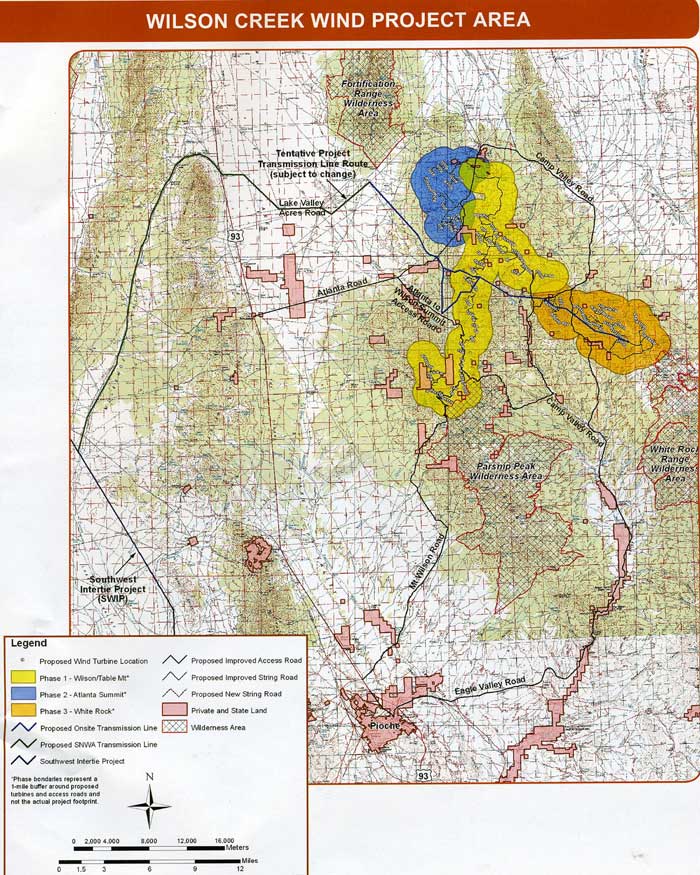
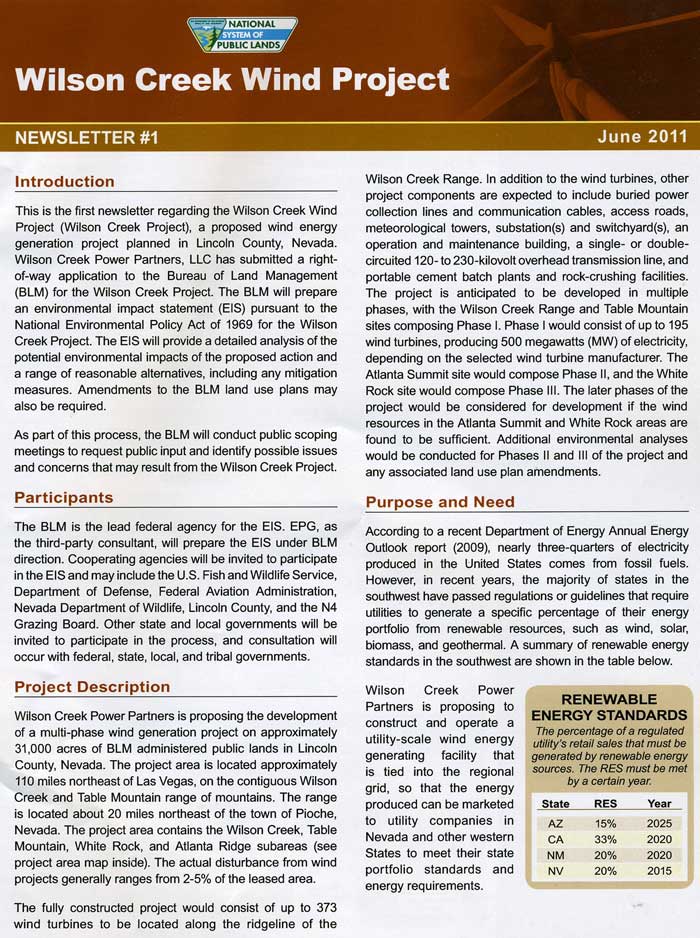
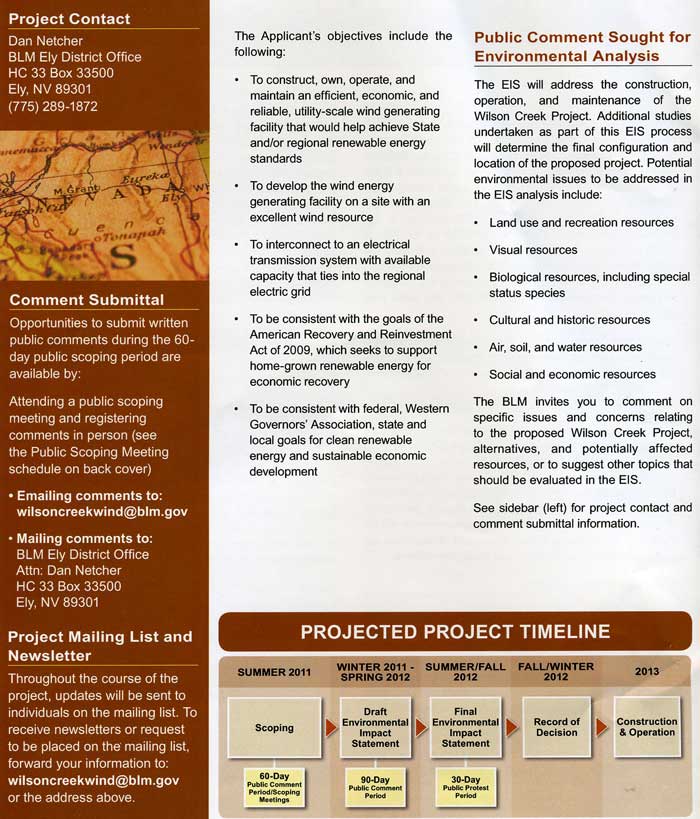
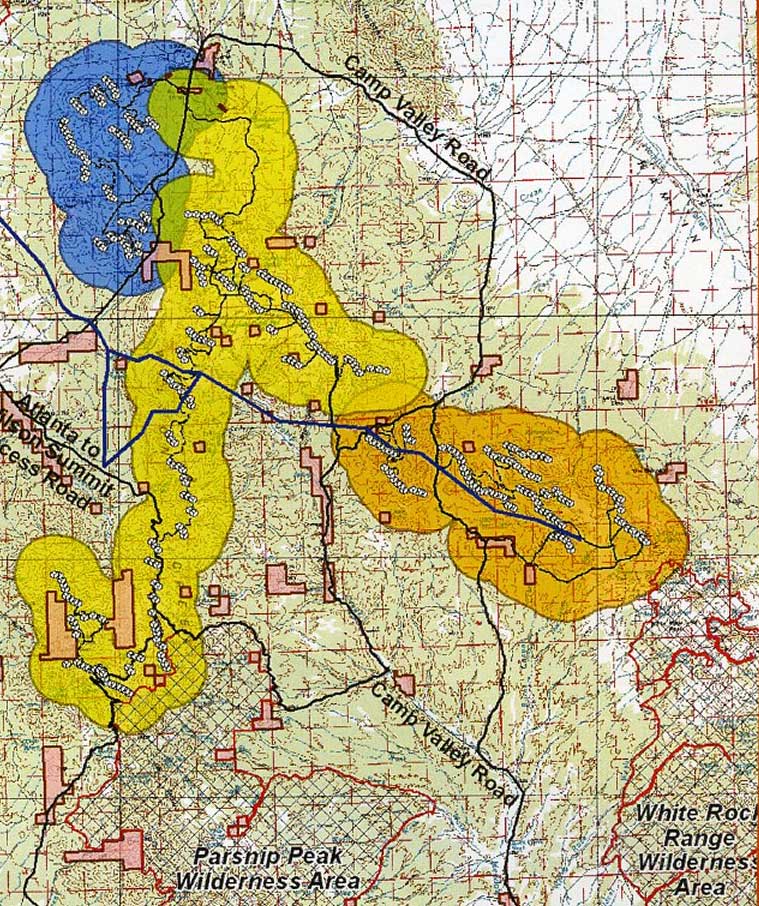
^Detail of map of proposed Wilson Creek Wind Project, showing three phases. Note the Wind Turbine Generators proposed to be placed right along the boundary of Parsnip Peak Wilderness.
Lincoln County Resource Conservation Group Comment Letter

^Diverse alpine grassland with paintbrush on the Wilson Creek Wind Project site, near Mt. Wilson and the boundary of Parsnip Peak Wilderness.
July 8, 2011 - This article was published in the local Lincoln County Record:
Mount Wilson, Table Mountain, White Rock Mountain and the Atlanta Summit Area
The proposed Wilson Creek Wind Project Public Scoping Meeting will be held at Pioche Elementary School on Wednesday, July 13, from 5:30 to 7:30 pm. For those who might be concerned about the permanent negative impacts to the Mount Wilson, Table Mountain, White Rock Mountain, and Atlanta Summit areas of Lincoln County, this is the time to be heard. If implemented, this project will devastate our precious mountain resources that have been a positive focal point in Lincoln County for generations.
For several years, the Board of Lincoln County Commissioners has taken a strong position against the proposed location of this wind project because of the irreversible impacts to the natural and cultural resources. These mountains represent “Multiple-Use” Public Land at its very best and those uses will be lost upon approval of this project. Lincoln County is, and always has been in favor of renewable energy development, in the right location where the development is compatible with the existing uses and resources. These mountains are not the right location for a wind farm totaling approximately 375 turbines towering over 400 feet in height, in which the “right-of-way” totals 31,000 acres. Taken as a whole, this project basically encompasses the vast area on these mountains that Wilderness Areas do not cover. The negative impacts of this project are far greater than the conceivable “return” that is being touted under the guise of “green energy.”
During construction, roads must be built and be able to accommodate the many heavy loads of the turbine components. An example is the moderately sized GE 1.5 Megawatt Turbine; altogether the tower, blade assembly, and gearbox weigh over 163 tons. These components must be transported on trucks and trailers that need strong roads, wide turns and gentle grades. The roads on these mountains will have to be built to the equivalent of a major highway. To achieve this type of standard, millions of tons of earth will be removed and displaced during the road building phase of this project. Bedrock will have to be blasted and the ultimate leveling of peaks and ravines will occur. There are also roads needed for long-term maintenance and transportation within the project area, as well as transmission lines, communication lines, switch-yards, substations, and maintenance facilities.
Concrete needed for the turbine foundations will also be necessary. The approximate volume for turbine type and location vary, but 300-400 cubic yards per turbine is average. The Spring Valley Project in White Pine County is a good example where over 400 cubic yards per turbine is being used. For this project the equivalent of 15,000 truckloads of concrete would be needed. The aggregates for concrete will have to come from somewhere; whether it is taken out of the mountains themselves or simply transported from another location.
Construction will significantly affect the five watersheds that divide the proposed project area. Noxious weeds such as cheat grass, white top, halegeton, and thistle, which will flourish immediately following ground disturbance, need only the vessel of one rain event to infest many thousands of acres within the drainages that feed the lower elevations from these mountains. Weed infestations will be present all over the project area given the excessive road network that will be needed. Private property and riparian corridors will be drastically affected. The amount of disturbance is such that large tracts of exposed soils will also allow intense run-off and other accelerated erosion.
All wildlife will be impacted severely. The Greater Sage Grouse is designated by the BLM as a Sensitive Species, subject to certain policies that focus management on conservation of habitat and other factors. Currently, the Sage Grouse is also “warranted but precluded” from a listing by the United States Fish and Wildlife Service under the Endangered Species Act. In other words, it should be listed but there are other species waiting in line ahead of it. These mountains are home to the core population of Sage Grouse in Lincoln County. A wind farm spells certain doom for these birds. Eliminating a local population like this simply puts Sage Grouse one step closer to an endangered species listing. Economical development, of any kind, is difficult enough in northern Lincoln County without requirements that come with endangered species. Permitted uses like grazing, as well as public access (roads) and other uses could be reduced and in some cases eliminated in the name of Sage Grouse recovery.

^Sage grouse.
The Nevada Department of Wildlife has designated these mountains as Crucial Summer Range for both Mule Deer and Elk. One cannot put a price on the quality of wildlife habitat that these mountains provide. Crucial Summer Habitat is very limited in Lincoln County and it is summer habitat that supports the offspring which ensure the survival of a particular species. This habitat will be severely affected due to the expansive road networks and other infrastructure. Several hundred operating turbines are enough in themselves to displace many of these animals, forcing them to areas less desirable; or worse yet, forcing them to places such as private farmlands and areas that will cause more negative impacts. Ultimately, the population will suffer.
For sportsman, these mountains are the most sought after hunting destination in Unit 231. This project will reduce the overall hunting opportunity in the unit significantly. Draw odds are very difficult in the limited entry hunt units. When Unit 231 loses a significant percentage of Mule Deer and Elk tags because the populations have suffered, the lasting impact will be more difficult draw odds in adjacent areas. Local economics also benefit greatly from the quality of hunting that these mountains provide. Sportsmen travel from all over the globe to experience what these mountains have to offer. Loss of opportunity forces hunters to other counties or even other states.
In terms of permitted use on these mountains, grazing is the most prominent. Summer grazing has been practiced on these mountains for generations. It rejuvenates the vegetation, provides sustainable income for a few hard working operators, and benefits local economics as well. The network of infrastructure and its effects on forage, coupled with the possible Sage Grouse issue spells difficult times ahead for those who have carved out a living utilizing these mountains.
Public access that has been present in these areas will become a distant memory if this project were to occur. Roads will be closed due to public safety, liability, and possible vandalism. Wind turbines have recommended safe distances when in operation of approximately 1200 to1500 feet. Local economics also benefit from tourism and those seeking adventure on our back country roads. Again, this will be limited and in some cases eliminated in these areas. Again, local economics will suffer.
Private property owners will also be impacted. Our neighbors on Mount Wilson will have flashing lights to view each night along with the constant noise that the turbines create. The view shed in these areas will be destroyed only to be replaced by roads, transmission lines, and turbines that will be visible from Pioche.
In terms of "Green Energy" and other popular notions, the facts are:
-Fossil fuels must be continuously burned during construction and operation of the project. Nothing is saved.
-With over 100,000 wind turbines in operation today in the world, not one conventional power plant has been shut down because of wind. Conventional plants must back up the intermittency of wind.
-Our nation's dependency on foreign oil has almost nothing to do with the amount of electrical energy produced by wind.
-There has been no science to prove any reduction in CO2 emissions related to wind production.
-The price of wind energy is far more expensive than conventional power.
-A recent study in the UK and New York State found that wind farms, most in prime wind areas, consistently produced less than 30% of their installed capacity. In most cases, it was closer to 25%. (New York State Energy Research and Development Authority)
-The jobs created on these projects will go to unions. Very few if any local workers will be employed. Very few permanent jobs will be present after construction.
For this project, there is currently no transmission capability from this project. It can be argued that the proponents are counting on the hastened construction of the SNWA pipeline and utility line for use in transporting their power out of state.
The benefits such as increase tax base for the county, increased revenue for businesses during the construction period, creation of jobs, and increasing our production of renewable energy, can all be realized by examining another location in the county. Alternative locations for this type of development can be found. Development of this magnitude must be done properly without impacting or eliminating numerous other beneficial uses and resources. Our precious mountains cannot be sacrificed for a project that is going to produce no more than 25% of its installed generating capacity. The power produced will not benefit Lincoln County and could be going out of state. This project will not reduce fossil fuel consumption. Simply put, Mount Wilson, Table Mountain, and White Rock Mountain should not be sacrificed.
Public Scoping Meetings for the Mount Wilson Wind Project will be at the following locations the week of July 11, 2011. All times will be 5:30-7:30 pm.
Monday, July 11, 2011: BLM Las Vegas Field Office, 4701 N. Torrey Pines Drive
Tuesday, July 12, 2011: Springhill Suites Conference Room, Cedar City, UT, 1477 South Old Highway 91
Wednesday, July 13, 2011: Pioche Elementary School Gym, 95 Airport Road
Thursday, July 14, 2011: Prospector Hotel Conference Room, Ely, 1501 Aultman Street
Respectfully submitted by the Lincoln County Resource Conservation Group
Environmental Review Pushes Forward
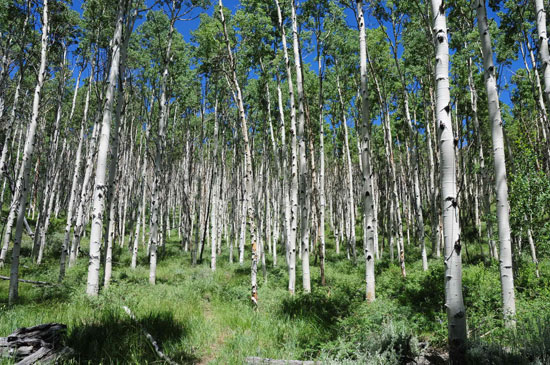
^Aspens in Nevada.
May 28, 2011 - Comments are needed.
http://www.gpo.gov/fdsys/pkg/FR-2011-05-27/html/2011-13010.htm
Federal Register Volume 76, Number 103 (Friday, May 27, 2011)]
[Notices]
[Pages 30963-30964]
From the Federal Register Online via the Government Printing Office [www.gpo.gov]
[FR Doc No: 2011-13010]
-----------------------------------------------------------------------
DEPARTMENT OF THE INTERIOR
Bureau of Land Management
Notice of Intent To Prepare an Environmental Impact Statement for
the Proposed Wilson Creek Wind Project, Lincoln County, NV
AGENCY: Bureau of Land Management, Interior.
ACTION: Notice of Intent.
-----------------------------------------------------------------------
SUMMARY: In compliance with the National Environmental Policy Act (NEPA) of 1969, as amended, and the Federal Land Policy and Management Act of 1976, as amended, the Bureau of Land Management (BLM) Schell Field Office, Nevada, intends to prepare an Environmental Impact Statement (EIS) for a right-of-way (ROW) application submitted by
Wilson Creek Power Partners, LLC, for a wind energy generation project and by this notice is announcing the beginning of the scoping process to solicit public input on the identification of issues. The BLM may also determine that the proposed project would require an amendment to the Ely Resource Management Plan, in which case the EIS would support any planning amendment.
DATES: This notice initiates the public scoping process for the EIS. Comments on issues may be submitted in writing until July 26, 2011. The date(s) and location(s) of any scoping meetings will be announced at least 15 days in advance through local media, newspapers and the BLM Web site at: http://www.blm.gov/nv/st/en/fo/ely_field_office.html.
In order to be considered in the Draft EIS, all comments must be received prior to the
close of the scoping period or 15 days after the last public meeting, whichever is later. The BLM will provide additional opportunities for public participation upon publication of the Draft EIS.
ADDRESSES: You may submit comments on issues related to the Proposed Wilson Creek Wind Project by any of the following methods:
Web site: http://www.blm.gov/nv/st/en/fo/ely_field_office.html.
E-mail: wilsoncreekwind@blm.gov.
Fax: (775) 775-1918 (attention Dan Netcher).
Mail: BLM Ely District Office, Attn: Dan Netcher, HC 33
Box 33500 Ely, NV 89301.
In person: at the BLM Ely District Office and at any public scoping meetings on the proposal. Documents pertinent to this proposal may be examined at the BLM Ely
District Office, 702 North Industrial Way, Ely, Nevada.
FOR FURTHER INFORMATION CONTACT: Dan Netcher, Renewable Energy Project Manager, (775) 289-1872; or e-mail wilsoncreekwind@blm.gov. You may also use this contact information to request that your name be added to the project mailing list. Persons who use a telecommunications device for the deaf (TDD) may call the Federal Information Relay Service (FIRS) at 1-800-877-8339 to contact the above individual during normal business hours. The FIRS is available 24 hours a day, 7 days a week, to leave a message or question with the above individual. You will receive a reply during normal business hours.
SUPPLEMENTARY INFORMATION: The applicant, Wilson Creek Power Partners, LLC, has requested a ROW authorization to construct, operate, maintain, and decommission a multi-phase wind powered generation facility on approximately 31,000 acres of BLM administered public lands in Lincoln County, Nevada. The fully constructed project would consist of 336 to 373 wind turbines to be located along the ridgeline of the Wilson Creek
Range approximately 20 miles northeast of the town of Pioche, Nevada. In addition to the wind turbines, other project components are expected to include buried power collection lines and communication cables, access roads, meteorological towers, substation(s) and switchyard(s), an operation and maintenance building, a single or double-circuited 120
to 230 kilovolt overhead transmission line, and portable cement batch plants and rock crushing facilities. The project is anticipated to be developed in multiple phases, with the Wilson Creek Range and Table Mountain sites composing Phase I. Phase I would consist of up to 195 wind turbines, producing 500 megawatts (MW) of electricity, depending
on the selected wind turbine manufacturer. The Atlanta Summit site would compose Phase II, and the White Rock site would compose Phase III. The later phases of the project would be considered for development if the wind resource in the Atlanta Summit and White Rock areas is found to be sufficient. Additional environmental analysis
would be conducted for Phases II and III of the project and any associated land use plan amendments. The purpose of the public scoping process is to determine relevant issues that will influence the scope of the environmental analysis and guide the process for developing the EIS, including the development of alternatives. The BLM has identified
the following preliminary issues: Threatened and endangered species; wildlife, particularly avian species; visual resource impacts; recreation impacts; and socioeconomic effects. Authorization of this proposal may require an amendment of the Ely Resource Management Plan (2007). By this notice, the BLM is complying with requirements in 43
CFR 1610.2(c) to notify the public of potential amendments to land use plans. If a land use plan amendment is necessary, the BLM will integrate the land use planning process with the NEPA process for this project.
The BLM will use and coordinate the NEPA commenting process to satisfy the public involvement requirements of Section 106 of the National Historic Preservation Act (16 U.S.C. 470f), as provided for in 36 CFR 800.2(d)(3). Native American Tribal consultations will be conducted in accordance with BLM policy, and tribal concerns including potential impacts on Indian trust assets will be given due consideration. Federal, State, and local agencies, along with other stakeholders that may be interested in or affected by the BLM's
decision(s) are invited to participate in the scoping process and, if eligible, request or be requested by the BLM to participate as a cooperating agency.
Before including your address, phone number, e-mail address, or other personal identifying information in your comment, you should be aware that your entire comment--including your personal identifying information--may be made publicly available at any time. While you can ask us in your comment to withhold your personal identifying
information from public review, we cannot guarantee that we will be able to do so.
Mary D'Aversa,
Manager, Schell Field Office.
Just Move the Elk Off the Mountain: Mt. Wilson Wind Project
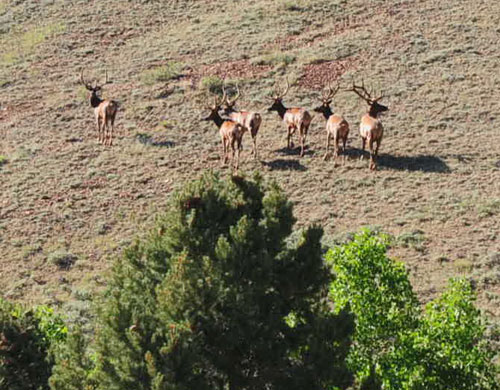
September 4, 2010 - Lincoln County, Nevada - "If you go in and put wind turbines on Mount Wilson, the sage grouse are gone," Lincoln County Wildlife Advisory Board Chairman Cory Lytle. The Greater sage grouse was denied federal protection this year, and instead agencies and energy companies were supposed to work out agreements to preserve important core areas and breeding grounds, such as the leks on the Wilson Creek Range.
Discussions of the clash of wind projects and wildlife took place at a sportmen meeting hosted by the Coalition for Nevada's Wildlife, the National Wildlife Federation, and the Desert-Las Vegas Chapter of Safari Club International.
The Wilson Creek Range has been designated by the Bureau of Land Management as "crucial" fawning grounds for mule deer and elk. Michael McBeath, a member of the Nevada Board of Wildlife Commissioners, described the project area as "the crown jewel of Lincoln County." He said the wind farm, if built, would disrupt paths that deer and elk follow to reach food and water resources.
Nevada Wind Co. and Horizon Wind have identified a project area on Table Mountain/Mt. Wilson and have installed several anemometers at the site. Nevada Wind is in the wind monitoring process to acquire the data for a possible wind generation project.
Nevada Wind Managing Partner Tim Carlson said he understands the concerns but that wildlife issues can be mitigated. Elk could be relocated to wilderness areas near the project. We would not call this mitigation.
See the Las Vegas Review-Journal, and Bureau of Land Management Ely office.
Plan of Development
September 12, 2010 - Final Plan of Development from Bureau of Land Management (21 MB pdf).
